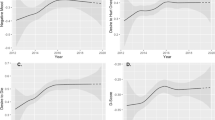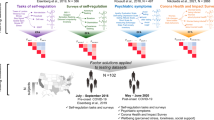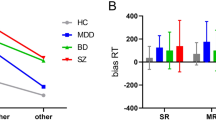Abstract
Introduction
In a previously published randomized controlled trial, automated self-association training (ASAT), a novel digital intervention, was found to extend the rapid antidepressant effect of a single infusion of ketamine for at least 30 days. In this secondary analysis, we aimed to understand the potential role of implicit self-esteem in the combined antidepressant effect of ketamine and ASAT training, by investigating the novel synergistic treatment’s effects on implicit self-associations and their relation to symptom improvement.
Methods
A total of 154 adults (ages 18–60) with treatment-resistant unipolar depression and lower-than-normative explicit self-esteem were randomized in a double-blind, parallel-arm design to receive one of three treatment allocations: an active/active treatment combination consisting of one infusion of ketamine (0.5 mg/kg) followed by four days of ASAT ( ~ 30–40 min/day), or one of two control arms that lacked either the active drug or the active behavioral component. The Implicit Association Test (IAT) was used to behaviorally assess the strength of association between self-related stimuli and negative concepts. Linear regression models were used to test the relationship between group assignment, IAT scores acquired immediately post-treatment, and both acute and extended clinical outcomes (% change in Montgomery-Asberg Depression Rating Scale scores, relative to pre-treatment baseline) in the trial.
Results
The group assigned to ketamine + ASAT intervention, compared to the other groups, had a pattern of IAT scores indicating more positive self-associations immediately after treatment relative to the control arms (F(1, 131) = 3.979; p = 0.048). In regression models, IAT scores tracked with concurrent (acute post-treatment) % change in MADRS scores across all treatment arms (p = 0.001), and mediated more extended (Day 30) depression improvements specifically for the ketamine+ASAT arm (group * IAT interaction term: β = –0.201; p = 0.049).
Discussion
Our findings suggest that changing implicit self-worth during a post-ketamine ‘plasticity window’ is one key mechanism whereby the novel ketamine+ASAT treatment combination exerts its antidepressant benefit, confirming the intended treatment target at the level of implicit cognition. Future studies should seek to further enhance the reliability of the biobehavioral intervention’s impact on implicit cognition, as this mechanism appears linked to the intervention’s enduring clinical benefits.
This is a preview of subscription content, access via your institution
Access options
Subscribe to this journal
Receive 12 print issues and online access
$259.00 per year
only $21.58 per issue
Buy this article
- Purchase on Springer Link
- Instant access to full article PDF
Prices may be subject to local taxes which are calculated during checkout



Similar content being viewed by others
Data availability
The datasets analyzed during the current study are available from the corresponding author on reasonable request.
References
Website n.d. Institute of Health Metrics and Evaluation. Global Health Data Exchange (GHDx). http://ghdx.healthdata.org/gbd-results-tool?params=gbd-api-2019-permalink/d780dffbe8a381b25e1416884959e88b.
Liu B, Liu J, Wang M, Zhang Y, Li L. From serotonin to neuroplasticity: evolvement of theories for major depressive disorder. Front Cell Neurosci. 2017;11:305.
Castrén E, Monteggia LM. Brain-derived neurotrophic factor signaling in depression and antidepressant action. Biol Psychiatry. 2021;90:128–36.
Duman RS, Aghajanian GK, Sanacora G, Krystal JH. Synaptic plasticity and depression: new insights from stress and rapid-acting antidepressants. Nat Med. 2016;22:238–49.
Kang HJ, Voleti B, Hajszan T, Rajkowska G, Stockmeier CA, Licznerski P, et al. Decreased expression of synapse-related genes and loss of synapses in major depressive disorder. Nat Med. 2012;18:1413–7.
Sen S, Duman R, Sanacora G. Serum brain-derived neurotrophic factor, depression, and antidepressant medications: meta-analyses and implications. Biol Psychiatry. 2008;64:527–32.
Kopelman J, Keller TA, Panny B, Griffo A, Degutis M, Spotts C, et al. Rapid neuroplasticity changes and response to intravenous ketamine: a randomized controlled trial in treatment-resistant depression. Transl Psychiatry. 2023;13:159.
Kang MJY, Hawken E, Vazquez GH. The mechanisms behind rapid antidepressant effects of ketamine: a systematic review with a focus on molecular neuroplasticity. Front Psychiatry. 2022;13:860882.
Price RB, Spotts C, Panny B, Griffo A, Degutis M, Cruz N, et al. A novel, brief, fully automated intervention to extend the antidepressant effect of a single ketamine infusion: a randomized clinical trial. Am J Psychiatry. 2022;179:959–68.
Price RB, Wallace ML, Mathew SJ, Howland RH. One-year outcomes following intravenous ketamine plus digital training among patients with treatment-resistant depression: A secondary analysis of a randomized clinical trial. JAMA Netw Open. 2023;6:e2312434.
Phillips WJ, Hine DW, Thorsteinsson EB. Implicit cognition and depression: a meta-analysis. Clin Psychol Rev. 2010;30:691–709.
Gotlib IH, Hammen CL Handbook of Depression, Second Edition. Guilford Press; (2008).
De Houwer J, Thomas S, Baeyens F. Associative learning of likes and dislikes: a review of 25 years of research on human evaluative conditioning. Psychol Bull. 2001;127:853–69.
Greenwald AG, McGhee DE, Schwartz JLK. Measuring individual differences in implicit cognition: The implicit association test. Journal of Personality and Social Psychology. 1998;74:1464–80. https://doi.org/10.1037/0022-3514.74.6.1464.
Brand R Using Substances to Enhance Performance: A Psychology of Neuroenhancement. Frontiers Media SA; (2017).
Greenwald AG, Poehlman TA, Uhlmann EL, Banaji MR. Understanding and using the Implicit Association Test: III. Meta-analysis of predictive validity. J Pers Soc Psychol. 2009;97:17–41.
Martin-Soelch C, Linthicum J, Ernst M. Appetitive conditioning: neural bases and implications for psychopathology. Neurosci Biobehav Rev. 2007;31:426–40.
Werntz AJ, Steinman SA, Glenn JJ, Nock MK, Teachman BA. Characterizing implicit mental health associations across clinical domains. J Behav Ther Exp Psychiatry. 2016;52:17–28.
Price RB, Nock MK, Charney DS, Mathew SJ. Effects of intravenous ketamine on explicit and implicit measures of suicidality in treatment-resistant depression. Biol Psychiatry. 2009;66:522–6.
Price RB, Iosifescu DV, Murrough JW, Chang LC, Al Jurdi RK, Iqbal SZ, et al. Effects of ketamine on explicit and implicit suicidal cognition: a randomized controlled trial in treatment-resistant depression. Depress Anxiety. 2014;31:335–43.
Lane KA, Banaji MR, Nosek BA, Greenwald AG. Understanding and using the implicit association test: IV. Implicit Measures of Attitudes. 2007;59:102.
Price RB, Panny B, Degutis M, Griffo A. Repeated measurement of implicit self-associations in clinical depression: Psychometric, neural, and computational properties. J Abnorm Psychol. 2021;130:152–65.
Rosenberg M. Rosenberg self-esteem scale (RSE). Acceptance Commitment Therapy Measures Package. 1965;61:18.
Fritz MS, Mackinnon DP. Required sample size to detect the mediated effect. Psychol Sci. 2007;18:233–9.
Fitzmaurice G, Laird NM, Ware JH Applied Longitudinal Analysis. 2nd ed. Wiley-Blackwell; (2011).
Kraemer HC, Wilson GT, Fairburn CG, Agras WS. Mediators and moderators of treatment effects in randomized clinical trials. Arch Gen Psychiatry. 2002;59:877–83.
Kraemer HC, Kiernan M, Essex M, Kupfer DJ. How and why criteria defining moderators and mediators differ between the Baron & Kenny and MacArthur approaches. Health Psychol. 2008;27:S101–8.
Schatzberg AF. An innovative approach to extending the antidepressant effects of intravenous ketamine in major depression. Am J Psychiatry. 2022;179:890–1.
Nock MK, Banaji MR. Prediction of suicide ideation and attempts among adolescents using a brief performance-based test. J Consult Clin Psychol. 2007;75:707–15.
Franklin JC, Fox KR, Franklin CR, Kleiman EM, Ribeiro JD, Jaroszewski AC, et al. A brief mobile app reduces nonsuicidal and suicidal self-injury: evidence from three randomized controlled trials. J Consult Clin Psychol. 2016;84:544–57.
Teachman BA, Clerkin EM, Cunningham WA, Dreyer-Oren S, Werntz A. Implicit cognition and psychopathology: looking back and looking forward. Annu Rev Clin Psychol. 2019;15:123–48.
MacLeod C, Clarke PJF. The attentional bias modification approach to anxiety intervention. Clin Psychol Sci. 2015;3:58–78.
Price RB, Wallace M, Kuckertz JM, Amir N, Graur S, Cummings L, et al. Pooled patient-level meta-analysis of children and adults completing a computer-based anxiety intervention targeting attentional bias. Clin Psychol Rev. 2016;50:37–49.
Bar-Anan Y, Nosek BA. A comparative investigation of seven indirect attitude measures. Behav Res Methods. 2014;46:668–88.
Mitchell G, Tetlock PE Popularity as a poor proxy for utility. Psychological Science Under Scrutiny, Hoboken, NJ, USA: John Wiley & Sons, Inc.; p. 164–95. (2017).
Jost JT. The IAT is dead, long live the IAT: context-sensitive measures of implicit attitudes are indispensable to social and political psychology. Curr Dir Psychol Sci. 2019;28:10–9.
Barden J, Maddux WW, Petty RE, Brewer MB. Contextual moderation of racial bias: the impact of social roles on controlled and automatically activated attitudes. J Pers Soc Psychol. 2004;87:5–22.
Acknowledgements
Supported by National Institute of Mental Health Biobehavioral Research Awards for Innovative New Scientists (BRAINS) R01 grant R01MH113857 (Dr. Price) and by the Clinical and Translational Sciences Institute at the University of Pittsburgh (UL1-TR-001857). We are deeply grateful to the study participants for their time and dedicated collaboration in this work.
Author information
Authors and Affiliations
Contributions
RBP, SJW, and MLW conceived and designed the study. CS, BP, AG, MD, NC, EB, KD, RHH, and RBP conducted the study and collected the data. HNE and RBP analyzed the data. HNE drafted the manuscript. All authors revised the manuscript for important intellectual content and approved the final version.
Corresponding author
Ethics declarations
Competing interests
RBP work has been funded by the NIH. RBP is the named inventor on a University of Pittsburgh-owned patent filing related to the combination intervention described in this letter. MLW has served as a statistical consultant for Health Rhythms, Noctem Health, and Sleep Number Bed. SJM is supported through the use of facilities and resources at the Michael E. Debakey VA Medical Center, Houston, Texas, and receives support from The Menninger Clinic. SJM has served as a consultant to Alkermes, Allergan, Almatica, Axsome Therapeutics, Biohaven, BioXcel Therapeutics, Clexio Biosciences, Eleusis, EMA Wellness, Engrail Therapeutics, Greenwich Biosciences, Intra-Cellular Therapies, Janssen, Levo Therapeutics, Neurocrine, Perception Neuroscience, Praxis Precision Medicines, Relmada Therapeutics, Sage Therapeutics, Seelos Therapeutics, and Signant Health. He has received research support from Biohaven Pharmaceuticals, Boehringer-Ingelheim, Merck, Sage Therapeutics, and VistaGen Therapeutics. All other authors report no financial conflicts of interest to disclose.
Additional information
Publisher’s note Springer Nature remains neutral with regard to jurisdictional claims in published maps and institutional affiliations.
Supplementary information
Rights and permissions
Springer Nature or its licensor (e.g. a society or other partner) holds exclusive rights to this article under a publishing agreement with the author(s) or other rightsholder(s); author self-archiving of the accepted manuscript version of this article is solely governed by the terms of such publishing agreement and applicable law.
About this article
Cite this article
Eken, H.N., Spotts, C., Panny, B. et al. Improved implicit self-esteem is associated with extended antidepressant effects following a novel synergistic intervention. Mol Psychiatry (2024). https://doi.org/10.1038/s41380-024-02564-y
Received:
Revised:
Accepted:
Published:
DOI: https://doi.org/10.1038/s41380-024-02564-y



